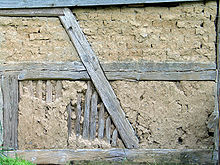Paws


Under the Klaiben (also klöben , klieben , glue , staken or pliestern ) is understood in the architecture of the activity of the filling of Staken , rind crate or wattle in the compartments of timbered walls and false ceilings with daub by Pliesterer . In Low German (Low German) language usage, the activity was called klehmen .
In the country in particular, pounding was used in half-timbered houses, barns and stables .
The production of corrugated walls from staked wood , which is wrapped with long straw and clay, as well as the production of clay floors was also referred to as plasterwork. The stakes were wrapped in a mixture of straw and clay ( Weller ) before being introduced . They could then be smoothed while still damp with the addition of a little more clay (to fill unevenness) (clay screed ).
After the thrown-on clay or wrapped straw clay had been spread and dried, a layer of clay plaster was often applied.
Remarks
- ↑ Stakes are rods, branches or wooden clubs pushed between the beams. See also: F. Triest, Königl. Prussian government council and building director in Berlin, manual for the calculation of building costs for all objects of urban and rural art. For the use of the individual trades and the technical officials, arranged in 18 departments - the ninth department, containing the work of the earthmaker and staker, the straw and reed decker, the shingle, splitter and spoon decker; Berlin, published by Duncker and Humblot, 1827; accessed in January 2017